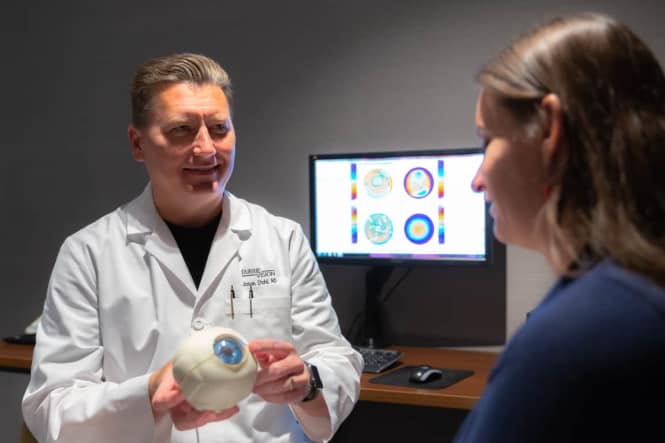Refractive errors are visual conditions that impact how clearly you can see up close and/or far away. These problems come from the shape of your cornea and the capability of your lens. When the eye can’t refract (bend) light properly, it can’t focus light directly onto the retina (film in the back of the eye). This is what causes straining and blurred vision.
Our refractive eye surgeons at Durrie Vision are dedicated to treating a variety of refractive errors for patients in the Kansas City area. Read on to learn more about what refractive errors are and how they’re diagnosed.
Types of refractive errors
There are four main types of refractive errors, some of which you could have simultaneously.
Nearsightedness (myopia): For those who are nearsighted, you may not have a problem seeing up close, but your distant vision becomes blurred. This is because you have too much focusing power due to a cornea that’s too steep. As a result, light focuses before hitting the retina.
Farsightedness (hyperopia): With farsightedness your cornea is too flat, causing your close-range vision to become distorted. Your focusing isn’t strong enough, so light focuses behind the retina.
Astigmatism: Astigmatism arises from an irregular shaped cornea. It’s common to have astigmatism along with farsightedness or nearsightedness.
Laser Surgery Options for Astigmatism Correction →
Presbyopia: As you age, your internal lens stiffens and loses its ability to zoom. Around your forties, you may notice that you have to hold a book out further and further to read. Then when your arms aren’t long enough, you’re forced to pick up reading glasses or get bifocals.
Cataracts: Cataracts are technically their own category, but they’re still important to keep in mind. Cataracts are another age-related condition where the lens clouds and yellows, blocking light from coming in and distorting vision.
Your Guide to Refractive Cataract Surgery →
How are refractive errors diagnosed?
Refractive errors are commonly diagnosed through vision tests. If you’ve ever visited an optometrist for glasses or contacts (not to be mistaken with an ophthalmologist), he or she would examine your eyes using a variety of tests such as vision charts.
However, at Durrie Vision our diagnostic screening goes beyond a test you would receive from an optometrist. Using the most advanced diagnostic testing and cutting-edge technology available, we provide high resolution 3D images of your entire eye to get a detailed glimpse of your refractive errors. This allows us to determine which vision correction procedure best suits your needs and lifestyle.
Get started with refractive eye surgery at Durrie Vision
Our number one goal is to help our patients better maneuver through life with the best vision possible. No matter the procedure, we use innovative laser technology to maximize precision so our patients receive the best results possible. We stick with our patients every step of the way, from the consultation all the way to the final visit.
For over 30 years, our doctors at Durrie Vision have been leaders in refractive surgery, offering all six options available today. To get started, schedule your AOA or take our easy online self-candidacy test.
Schedule a Consultation | Self Candidacy Test

Author Bio: Jason E. Stahl, MD
Top Doctors: https://www.castleconnolly.com/top-doctors/jason-e-stahl-ophthalmology-129cc002150
Best Cataract Surgeons: https://bestcataractsurgeons.com/cataract-surgeons/jason-e-stahl/

